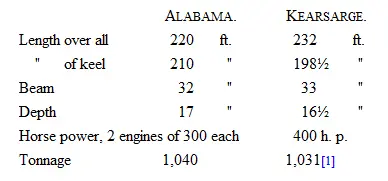Frederick Edge - An Englishman's View of the Battle between the Alabama and the Kearsarge
Здесь есть возможность читать онлайн «Frederick Edge - An Englishman's View of the Battle between the Alabama and the Kearsarge» — ознакомительный отрывок электронной книги совершенно бесплатно, а после прочтения отрывка купить полную версию. В некоторых случаях можно слушать аудио, скачать через торрент в формате fb2 и присутствует краткое содержание. Издательство: Иностранный паблик, Жанр: История, История, foreign_antique, foreign_prose, на английском языке. Описание произведения, (предисловие) а так же отзывы посетителей доступны на портале библиотеки ЛибКат.
- Название:An Englishman's View of the Battle between the Alabama and the Kearsarge
- Автор:
- Издательство:Иностранный паблик
- Жанр:
- Год:неизвестен
- ISBN:нет данных
- Рейтинг книги:3 / 5. Голосов: 1
-
Избранное:Добавить в избранное
- Отзывы:
-
Ваша оценка:
- 60
- 1
- 2
- 3
- 4
- 5
An Englishman's View of the Battle between the Alabama and the Kearsarge: краткое содержание, описание и аннотация
Предлагаем к чтению аннотацию, описание, краткое содержание или предисловие (зависит от того, что написал сам автор книги «An Englishman's View of the Battle between the Alabama and the Kearsarge»). Если вы не нашли необходимую информацию о книге — напишите в комментариях, мы постараемся отыскать её.
An Englishman's View of the Battle between the Alabama and the Kearsarge — читать онлайн ознакомительный отрывок
Ниже представлен текст книги, разбитый по страницам. Система сохранения места последней прочитанной страницы, позволяет с удобством читать онлайн бесплатно книгу «An Englishman's View of the Battle between the Alabama and the Kearsarge», без необходимости каждый раз заново искать на чём Вы остановились. Поставьте закладку, и сможете в любой момент перейти на страницу, на которой закончили чтение.
Интервал:
Закладка:
Frederick Milnes Edge
An Englishman's View of the Battle between the Alabama and the Kearsarge / An Account of the Naval Engagement in the British Channel, on Sunday June 19th, 1864
The Alabama and the Kearsarge
The importance of the engagement between the United States Sloop-of-war, Kearsarge, and the Confederate Privateer, Alabama, cannot be estimated by the size of the two vessels. The conflict off Cherbourg on Sunday, the 19th of June, was the first decisive engagement between shipping propelled by steam, and the first test of the merits of modern naval artillery. It was, moreover, a contest for superiority between the ordnance of Europe and America, whilst the result furnishes us with data wherefrom to estimate the relative advantages of rifled and smooth-bore cannon at short range.
Perhaps no greater or more numerous misrepresentations were ever made in regard to an engagement than in reference to the one in question. The first news of the conflict came to us enveloped in a mass of statements, the greater part of which, not to use an unparliamentary expression, was diametrically opposed to the truth; and although several weeks have now elapsed since the Alabama followed her many defenceless victims to their watery grave, these misrepresentations obtain as much credence as ever. The victory of the Kearsarge was accounted for, and the defeat of the Alabama excused or palliated upon the following principal reasons: —
1. The superior size and speed of the Kearsarge.
2. The superiority of her armament.
3. The chain-plating at her sides.
4. The greater number of her crew.
5. The unpreparedness of the Alabama.
6. The assumed necessity of Captain Semmes’ accepting the challenge sent him (as represented) by the commander of the Kearsarge.
Besides these misstatements there have been others put forth, either in ignorance of the real facts of the case, or with a purposed intention of diminishing the merit of the victory by casting odium upon the Federals on the score of inhumanity. In the former category must be placed the remarks of the Times (June 21st); but it is just to state that the observations in question were made on receipt of the first news, and from information furnished probably by parties unconnected with the paper, and desirous of palliating the Alabama’s defeat by any means in their power. We are informed in the article above referred to that the guns of the latter vessel “had been pointed for 2,000 yards, and the second shot went right through the Kearsarge,” whereas no shot whatever went through as stated. Again, “the Kearsarge fired about 100 (shot) chiefly 11-in. shell,” the fact being that not one-third of her projectiles were of that calibre. Further on we find – “The men (of the Alabama) were all true to the last; they only ceased firing when the water came to the muzzles of their guns.” Such a declaration as this is laughable in the extreme; the Alabama’s guns were all on the spar-deck, like those of the Kearsarge; and, to achieve what the Times represents, her men must have fought on until the hull of their vessel was two feet under water. The truth is – if the evidence of the prisoners saved by the Kearsarge may be taken – Captain Semmes hauled down his flag immediately after being informed by his chief engineer that the water was putting out the fires; and, within a few minutes, the water gained so rapidly on the vessel that her bow rose slowly in the air, and half her guns obtained a greater elevation than they had ever known previously. It is unfortunate to find such cheap-novel style of writing in a paper which at some future period may be referred to as an authoritative chronicler of events now transpiring.
It would be too long a task to notice all the numerous misstatements of private individuals, and of the English and French press in reference to this action: the best mode is to give the facts as they occurred, leaving the public to judge by internal evidence on which side the truth exists.
Within a few days of the fight, the writer of these pages crossed from London to Cherbourg for the purpose of obtaining by personal examination full and precise information in reference to the engagement. It would seem as though misrepresentation, if not positive falsehood, were inseparable from everything connected with the Alabama, for on reaching the French naval station he was positively assured by the people on shore that nobody was permitted to board the Kearsarge. Preferring, however, to substantiate the truth of these allegations, from the officers of the vessel themselves, he hired a boat and sailed out to the sloop, receiving on his arrival an immediate and polite reception from Captain Winslow and his gallant subordinates. During the six days he remained at Cherbourg, he found the Kearsarge open to the inspection, above and below, of any and everybody who chose to visit her; and he frequently heard surprise expressed by English and French visitors alike that representations on shore were so inconsonant with the truth of the case.
I found the Kearsarge lying under the guns of the French ship-of-the-line “Napoleon,” two cables’ length from that vessel, and about a mile and a half from the harbour; she had not moved from that anchorage since entering the port of Cherbourg, and no repairs whatever had been effected in her hull since the fight. I had thus full opportunity to examine the extent of her damage, and she certainly did not look at all like a vessel which had just been engaged in one of the hottest conflicts of modern times.
SIZE OF THE TWO VESSELS.
The Kearsarge, in size, is by no means the terrible craft represented by those who, for some reason or other, seek to detract from the honour of her victory; she appeared to me a mere yacht in comparison with the shipping around her, and disappointed many of the visitors who came to see her. The relative proportions of the two antagonists were as follows: —

1The Kearsarge has a four-bladed screw, diameter 12-ft 9-in. with a pitch of 20-ft.
The Alabama was a barque-rigged screw propeller, and the heaviness of her rig, and, above all, the greater size and height of her masts would give her the appearance of a much larger vessel than her antagonist. The masts of the latter are disproportionately low and small; she has never carried more than top-sail yards, and depends for her speed upon her machinery alone. It is to be questioned whether the Alabama, with all her reputation for velocity, could, in her best trim, outsteam her rival. The log book of the Kearsarge, which I was courteously permitted to examine, frequently shows a speed of upwards of fourteen knots the hour, and her engineers state that her machinery was never in better working order than at the present time. I have not seen engines more compact in form, nor, apparently, in finer condition; looking in every part as though they were fresh from the workshop, instead of being, as they, are, half through the third year of the cruise.
Ships-of-war, however, whatever may be their tonnage, are nothing more than platforms for carrying artillery. The only mode by which to judge of the strength of the two vessels is in comparing their armaments; and herein we find the equality of the antagonist as fully exemplified as in the respective proportions of their hulls and steam-power. The armaments of the Alabama and Kearsarge were are as follows:
ARMAMENT OF THE ALABAMA.

ARMAMENT OF THE KEARSARGE.
Читать дальшеИнтервал:
Закладка:
Похожие книги на «An Englishman's View of the Battle between the Alabama and the Kearsarge»
Представляем Вашему вниманию похожие книги на «An Englishman's View of the Battle between the Alabama and the Kearsarge» списком для выбора. Мы отобрали схожую по названию и смыслу литературу в надежде предоставить читателям больше вариантов отыскать новые, интересные, ещё непрочитанные произведения.
Обсуждение, отзывы о книге «An Englishman's View of the Battle between the Alabama and the Kearsarge» и просто собственные мнения читателей. Оставьте ваши комментарии, напишите, что Вы думаете о произведении, его смысле или главных героях. Укажите что конкретно понравилось, а что нет, и почему Вы так считаете.












